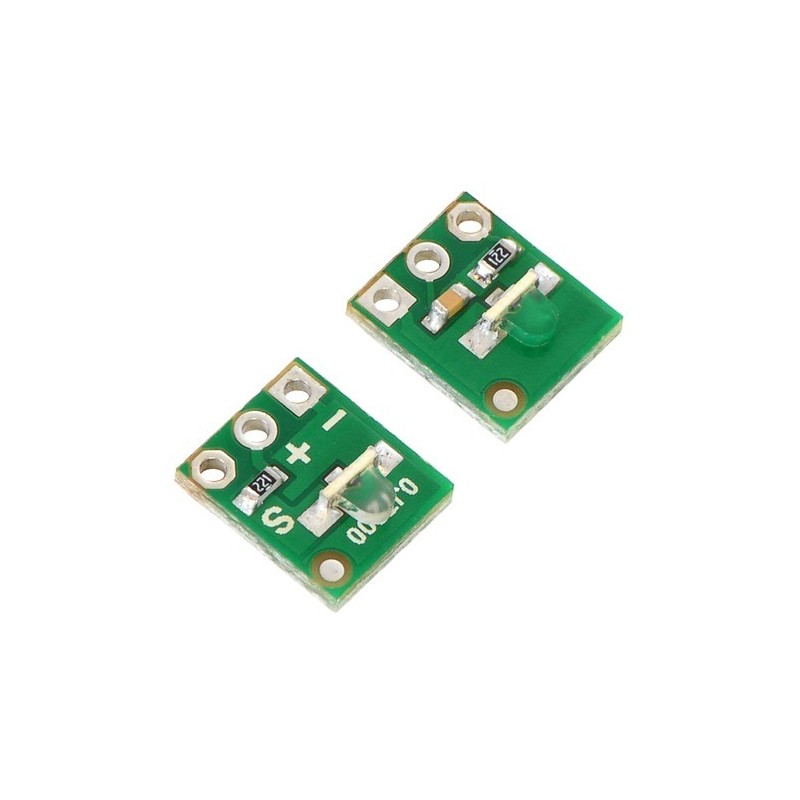

The QTR-L-1RC reflectance sensor incorporates a right-angle infrared LED and a right-angle phototransistor in an inexpensive, tiny 0.35" A— 0.3" module that can be mounted almost anywhere and is great for edge detection and line following. The output is designed to be measured by a digital I/O line. This sensor is sold in packs of two units.
Note: The QTR-L-1RC reflectance sensor requires a digital I/O line to take readings. The similar QTR-L-1A reflectance sensor is available with an analog output.
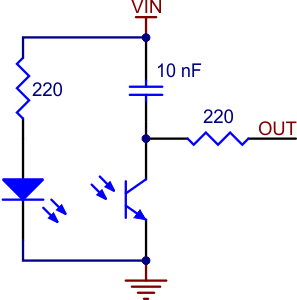 |
The Pololu QTR-L-1RC reflectance sensor carries a right-angle infrared LED and a right-angle phototransistor, both pointing toward the front edge of the board. The phototransistor uses a capacitor discharge circuit that allows a digital I/O line on a microcontroller to take an analog reading of reflected IR by measuring the discharge time of the capacitor. Shorter capacitor discharge time is an indication of greater reflection.
The LED current-limiting resistor is set to deliver approximately 17 mA to the LED when VIN is 5 V. The current requirement can be met by some microcontroller I/O lines, allowing the sensor to be powered up and down through an I/O line to conserve power.
This sensor was designed to be used with the board perpendicular to the surface being sensed, and narrow-angle lenses built into the infrared LED and phototransistor packages allow it to be effective to a range of about 1" (25 mm). Because of its small size, multiple units can easily be arranged to fit various applications such as line sensing and proximity/edge detection. The QTR-L-1RC is sold in packs of two units.
For a similar sensor that can be used with the board parallel to the surface, but with shorter range, please see the QTR-1RC reflectance sensor. We also offer arrays of three and eight sensors: the QTR-3RC reflectance sensor array and the QTR-8RC reflectance sensor array.
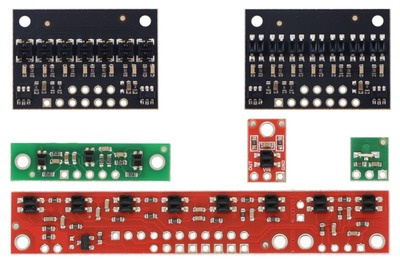 |
| QTR sensor size comparison. Clockwise from top left: QTR-3RC, QTR-1RC, QTR-L-1RC, QTR-8RC. |
|---|
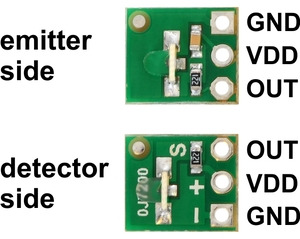 |
Like the Parallax QTI, the QTR-L-1RC module has sensor outputs that require a digital I/O line capable of first charging the output capacitor (by driving the line high) and then measuring the time for the capacitor to discharge through the phototransistor. This measurement approach has several advantages, especially when multiple units are used:
The typical sequence for reading a sensor is:
These steps can typically be executed in parallel on multiple I/O lines.
With a strong reflectance, the discharge time can be as low as several dozen microseconds; with no reflectance, the discharge time can be up to a few milliseconds. The exact time of the discharge depends on your microcontroller’s I/O line characteristics. Meaningful results can be available within 1 ms in typical cases (i.e. when not trying to measure subtle differences in low-reflectance scenarios), allowing up to 1 kHz sampling. The following table shows some typical discharge times (from 5 V down to a 2 V threshold) of the sensor over different surfaces and at different distances:
| White surface | 3/4" black electrical tape | |
|---|---|---|
| 0.25" distance | 100 ÎLs | 320 ÎLs |
| 1" distance | 160 ÎLs | 260 ÎLs |
Ambient light, especially sunlight, can affect the sensor readings significantly. If the discharge time of the QTR-L-1RC is consistently low, you might need to add shielding around the sensor or mount it in a different location to reduce interference from outside light sources.
Our Pololu AVR library provides functions that make it easy to use these sensors with our Orangutan robot controllers; please see the QTR Reflectance Sensors section of our library command reference for more information. We also have a Arduino library for these sensors.
Each pack of two reflectance sensors includes sets of straight male header strips and right-angle male header strips, which allow you to mount them in the orientation of your choice. You can also solder wires, such as ribbon cable, directly to the pads for the most compact installation.
|
|
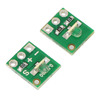 |
QTR-L-1A Reflectance Sensor (2-Pack) |
 |
QTR-1RC Reflectance Sensor |
 |
Female Crimp Pins for 0.1" Housings 100-Pack |
Manufacturer BTC Korporacja sp. z o. o. Lwowska 5 05-120 Legionowo Poland sprzedaz@kamami.pl 22 767 36 20
Responsible person BTC Korporacja sp. z o. o. Lwowska 5 05-120 Legionowo Poland sprzedaz@kamami.pl 22 767 36 20
Module with light sensor VEML7700. It allows you to measure the intensity in the range from 0 to 120 Klx. Equipped with a STEMMA QT connector, it communicates via the I2C interface. Adafruit 5378
Module with digital light sensor TSL2561. The board is equipped with a Grove connector and communicates via the I2C interface. Seeed Studio 101020030
Crowtail – Flame Sensor 2.0 is a module detecting infrared radiation and flame sources, operating in the range of 760–1100 nm. Intended for use in safety systems, robotics, and educational projects.
Module with an analog light sensor. It consists of a photoresistor and a LED. Equipped with a Gravity connector. DFRobot DFR0022
he flame detector module detects the source emitting a wavelength between 760 and 1100 nm. It allows to detect, among others source of fire. Analog interface. DFRobot DFR0076
No product available!
TSL25911FN light sensor module that can measure both visible and infrared light. It communicates via an I2C interface. Waveshare TSL25911 Light Sensor
DFRobot Gravity analog light intensity module for Arduino and Raspberry Pi. DFRobot DFR0026
No product available!
Module with light intensity sensor TSL2591. Equipped with STEMMA QT connector with I2C interface. Adafruit 1980
Module with a light sensor based on the APDS-9002 system. With the aid of this system, it is possible to measure the intensity of illumination in lux. The module has a connector in accordance with the Grove standard. Seeed studio 101020076
No product available!
A multifunctional module with an optical sensor for measuring the intensity of illumination, the color of the incident RGB light, the distance from the object and the detection of 3D gestures. Detection range from 10 to 20 cm, communication via I2C. SparkFun SEN-12787
Module with proximity and ambient light sensor based on the VCNL4020 system. It allows you to detect obstacles in the range from 0 to 20 cm and measure light intensity from 0.26 to 16,000 lux. It communicates via the I2C bus. Adafruit 5810
Sensor for detecting the distance, intensity and frequency of lightning within a radius of 40 km. The module enables weather enthusiasts to measure local storm data. SparkFun SEN-15441
No product available!
Module with a light sensor and a proximity sensor up to 5 cm. It allows you to read the illuminance from 0.01 to 64000 lux and communicates via the I2C interface. Pimoroni PIM413
The module allows the measurement of lighting in the vicinity of the sensor. The measuring range is from 1 to 65535 LUX, and communication takes place using the I2C bus. DFRobot SEN0097
KAmodVL6180X is a module that allows to measure light intensity (ALS), distance to the object and recognition of gesture. It has an embedded voltage regulator and voltage level translators on signal lines. Thanks to this can be used in systems with 2.8...5.5V power supply voltage.

